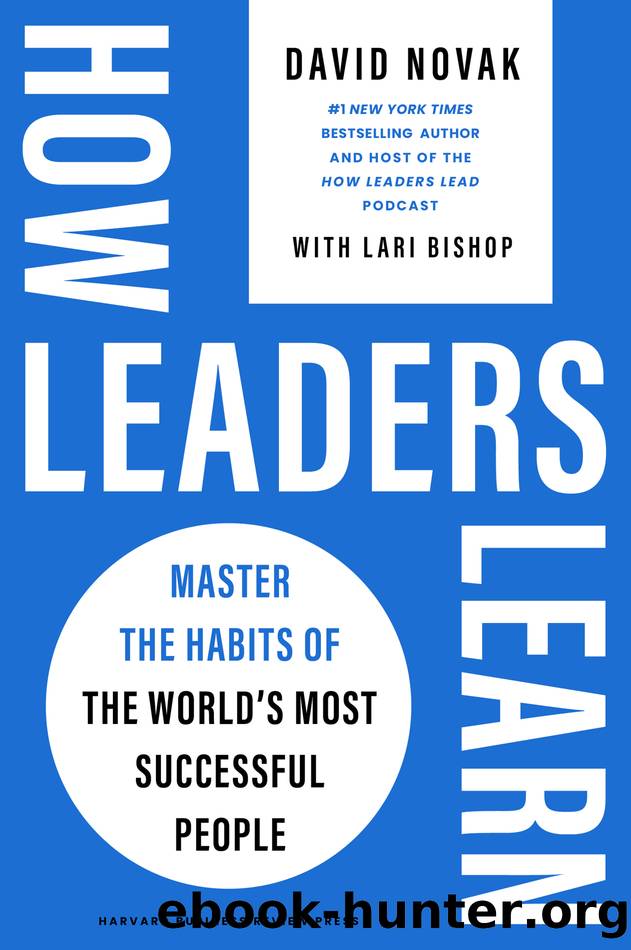How Leaders Learn by David Novak

Author:David Novak [Novak, with Lari Bishop, David]
Language: eng
Format: epub
Publisher: Harvard Business Review Press
Published: 2024-04-06T00:00:00+00:00
Chapter 16
Round Up on People
Learn to trust in positive intentions
Iâm a Theory Y leader all the way.
Back in 1960, Douglas McGregor, a management professor at MIT, described two leadership outlooks on human behavior in his book The Human Side of Enterprise. Those who fell into the Theory X category believed that employees had to be coerced, controlled, and threatened to do good work or take responsibility. Those who fell into Theory Y believed that people were generally creative, ingenious, and ready to take on responsibility, if they were treated accordingly.
I believe in running an organization based on the assumption that 99.9 percent of people want to do good, not bad or even mediocre, work. I trust in their positive intentions.
Active learners understand the power of trust and leverage it to learn more, faster. Trusting in positive intentions helps us overcome our natural defensiveness and listen with an open mind. It helps us overcome our bias against ideas from people we may not see as on our side - which is often just a story weâve made up about them. When we move beyond that kind of thinking, weâre more collaborative and we get to better action faster.
But that kind of trust doesnât always come naturally. Weâre too much on alert for threats in our environment. Weâre too ready to interpret peopleâs actions through a negative lens, especially when thereâs a long-standing issue or conflict. I donât want you to think Iâm naive, and I donât mean to sound like a Pollyanna. My biggest disappointments in life havenât been in business results or ideas that flopped - theyâve been in people who have betrayed my trust. But I know that itâs still worth starting from a position of trust.
In 1994, Wayne Calloway, chairman of PepsiCo, asked me if I would want to be president of KFC (I was COO of Pepsi-Cola, the beverage division, at the time). I pretended that I needed some time to talk it over with my family, but I knew Iâd say yes. And I knew Wendy would support me in that decision. I couldnât wait to get started.
When I accepted the job, I got more calls offering condolences than congratulations. Wayne asked me to take the job because I had built a reputation for helping to turn around struggling businesses - and KFC had been struggling under PepsiCoâs ownership. It never achieved its business plan and had had no same-store sales growth for seven straight years. It had become a graveyard for PepsiCo executives. To franchisees, who owned 70 percent of the KFC restaurants, corporate was seen as a bunch of outsiders who didnât enjoy fried chicken and didnât believe KFC could beat our competitors. They also held a majority of the marketing votes, which meant they controlled everything from advertising to new products, and they often voted as a bloc - against us. Trust was so frayed at the time that the franchisees were suing us over territorial rights.
I had inherited a business in decline and a broken franchise system waging open warfare with us.
Download
This site does not store any files on its server. We only index and link to content provided by other sites. Please contact the content providers to delete copyright contents if any and email us, we'll remove relevant links or contents immediately.
Hit Refresh by Satya Nadella(9038)
The Compound Effect by Darren Hardy(8808)
Change Your Questions, Change Your Life by Marilee Adams(7635)
Nudge - Improving Decisions about Health, Wealth, and Happiness by Thaler Sunstein(7615)
The Black Swan by Nassim Nicholas Taleb(7010)
Deep Work by Cal Newport(6879)
Daring Greatly by Brene Brown(6445)
Rich Dad Poor Dad by Robert T. Kiyosaki(6401)
Principles: Life and Work by Ray Dalio(6210)
Man-made Catastrophes and Risk Information Concealment by Dmitry Chernov & Didier Sornette(5921)
Playing to Win_ How Strategy Really Works by A.G. Lafley & Roger L. Martin(5919)
Digital Minimalism by Cal Newport;(5664)
Big Magic: Creative Living Beyond Fear by Elizabeth Gilbert(5610)
The Myth of the Strong Leader by Archie Brown(5425)
The Slight Edge by Jeff Olson(5346)
Discipline Equals Freedom by Jocko Willink(5285)
The Motivation Myth by Jeff Haden(5156)
Stone's Rules by Roger Stone(5026)
The Laws of Human Nature by Robert Greene(4998)
